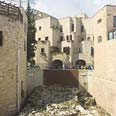
The Jewish Quarter
צילום: רון פלד
Jewish soul
Get emotional in a house that the Romans burned when the city was destroyed; admire synagogues that flourished under the Turkish rule; remember lost battles of 1947-8. Old, new in Jewish Quarter
The Jewish Quarter in the Old City of Jerusalem offers its visitors an interesting combination of museums and historic sites only minutes away from the Western Wall. A self-guided tour for a feel of the special ambience there can be followed by visits to the museums, one by one (for an admission fee).
The Batey Mahase (Shelters) Square used to be the center of the Jewish Quarter, around which new houses were built in the 19th century to help the crowded population there. The houses were built by the Holland Kolel of Germany and assigned to the Jerusalem poor.
In 1981, the Rothschild family built the House of Arches on top of which one can see the family emblem, with the words "honor," "hard work" and "integrity" inscribed in Latin. A building of domes on the southern side of the square used to serve as the quarter's school. Next to the Rothschild house, stands a monument commemorating the warriors who fell fighting here in 1947-8.

Batey Mahase Square (Photo: Ron Peled)
The four Sephardi synagogues on Mishmarot Kehuna Street demonstrate the importance of that community in the quarter, which dates back to the 16th century.
Because the Turks would not allow prayer houses to be higher than the mosques, the synagogues were built some three meters under the street level. First, we see the Rabbi Yohana Ben Zakay Synagogue with its splendor. An opening in the wall takes us through a roofed passage to what has been known as the Middle Synagogue, or Kahal Zion, built where the Ramban Synagogue's women section used to be.
Next, we find the Istanbuli Synagogue, which opened for worship in 1764, and the Eliyahu Hanavi Synagogue, which is the oldest and holds an impressive wooden ark that was brought from Livorno, Italy, after World War 2.
The synagogue complex is open only on weekdays, while only the quarter residents may visit them on weekends and holidays. For information: 972-2-6280592.
The Burnt House
One of the most impressive archaeological sites in Jerusalem is found on Karaim St. A museum on site shows artifacts from six wealthy houses, dating back to the Second Temple. It is located on the slopes of the hill overlooking Temple Mount and focuses on Jerusalem's aristocracy of the Herodian period.
The relics, found in the basements of those buildings, attest to their owners' wealth. The houses had storage rooms, water pools, mikvahs, baths, wonderful mosaics, plaster designs, and frescos. Excavations there discovered decorative and luxury items attesting to a highly developed dwelling culture, including terra cotta plates, wine carafes, and other stoneware that priests' families used to cleanse themselves with.
The most important building there is known as "the big house." Its rooms are highly decorated, and its balcony had a view of temple mount. These houses were destroyed and burned during the rebellion against the Romans in 70AD. For information: 972-2-6283448.
Nearby, on Tiferet Israel St., stands the Burnt House, an archaeological site preserving the house of the Jewish Bar-Kathros family, that was burned when the Second Temple was destroyed.
A visit to the small museum is particularly moving due to the findings there from the moment of destruction. Among other things, it displays a spear, nails, and the arm bone of a woman who perished in the fire. A slide show presents the way of life in those times. For information: 972-2-6288141.
The Cardo wonders
The Cardo, the main street of Byzantine Jerusalem, displays just what a glorious city it was back then.
Presently packed with tourist shops (with souvenirs such as golden medallions, stars of David in silver, mezuzot, and paintings), the Cardo holds a segment of 180mt of the ancient street excavated here, including a small museum that shows pictures of the day the Jewish Quarter fell in 1947, taken by John Philips, a Life Magazine photographer who lived in Jerusalem then as the guest of the Jordanian legion. For information: 972-2-6273916.
A tour of the Jewish Quarter would not be complete without visiting the museum of the Yitzhak Kaplan Old Yishuv Court in the Weingarten family 500-years old house.
Through crafts and artifacts, furniture and clothes, this museum shows how the Jewish community lived there between the 16th century and 1948, when the Quarter fell into Jordanian hands. In the center of the museum you can find the room in which the Holy Ari (Cabbalist Rabbi Isaac Luria) was born, which later turned into a synagogue bearing his name. For information: 972-2-6276319.










